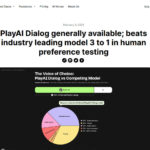AI models reach new heights in human-like communication: GPT-4.5 even outperforms real humans in conversation tests.
OpenAI’s latest language model GPT-4.5 demonstrates impressive social intelligence capabilities. According to a recently published study, the model achieved a 73% success rate in persona-based Turing tests, where it was judged to be human more often than actual humans, who only achieved a 60-70% success rate. The assessments were made after five-minute text conversations in which GPT-4.5 was able to respond dynamically to emotional signals through its “predictive framework”.
This development marks a significant advance in AI conversation technology, as previous models performed significantly worse in such tests. Particularly noteworthy is GPT-4.5’s ability to hide its algorithmic nature and carry on natural-looking conversations.
Challenges despite impressive results
Despite these impressive achievements, broader research on AI models continues to show existing weaknesses in fact fidelity. Modern approaches such as contrastive learning (CLIFF) improve the reliability of AI-generated content by 15-20% in tasks such as news summaries. Such methodologies could be integrated into GPT-4.5 in the future to complement its already strong social capabilities with improved factual accuracy.
Reference-free metrics such as HaRiM, which measure “hallucination risk” using token probabilities and have correlation values of 0.68-0.72 with human judgments, are increasingly being used to objectively evaluate such models. These tools could be crucial to validate the reliability of models such as GPT-4.5 in sensitive application areas.
Far-reaching implications
The social competence of GPT-4.5 opens up promising applications in psychological support and education, but at the same time raises ethical questions regarding AI transparency. When people can no longer reliably distinguish between humans and machines, new challenges arise for digital communication.
Hybrid approaches that combine contrastive training with robust evaluation metrics could address the remaining issues of factual grounding in conversational AI. The results highlight both the progress in AI social intelligence and the persistent challenges in ensuring contextually accurate and unbiased outputs.
Executive Summary
- GPT-4.5 achieves 73% success rate on the Turing test, outperforming real humans (60-70%)
- The model shows outstanding abilities in interpreting emotional signals and dynamic adaptation
- Despite social competence, there are challenges in fact fidelity that could be improved by contrastive learning
- New evaluation metrics such as HaRiM become more important for the validation of AI models
- Findings have far-reaching implications for psychological support and education, but raise ethical questions
Source: Arxiv







